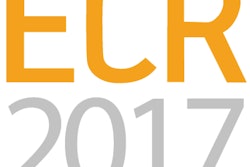
For decades, the world of medical imaging has been visualized in shades of gray. But as color is becoming more common, challenges are emerging that mirror those solved years ago in grayscale imaging, namely regarding the use of standards to define the consistency of color images shown on different medical displays.
Fortunately, help is on the way, according to a talk by Tom Kimpe, PhD, vice president of technology and innovation at display developer Barco. At the recent American Association of Physicists in Medicine (AAPM) meeting in Anaheim, CA, Kimpe reviewed ongoing progress toward defining a display standard for color images that is similar to the DICOM Grayscale Standard Display Function (GSDF).
One standard to rule them all
GSDF enables all display monitors to be calibrated to a single standard, ensuring consistency and accuracy in the interpretation of grayscale images. Such a standard is lacking for color, even as new clinical applications drive its growing use in medical imaging, Kimpe said.
"More and more x-ray images are being replaced by fused and multimodality or dual-energy images which use color," he told AAPM 2015 attendees. "But whereas for grayscale images, more than 10 years ago standards were implemented which rule their visualization ... for color images, there are no standards which state clearly how they ought to be displayed."
 Tom Kimpe, PhD, spoke on behalf of the ICC Medical Imaging Working Group at AAPM 2015.
Tom Kimpe, PhD, spoke on behalf of the ICC Medical Imaging Working Group at AAPM 2015.This is a problem because there's a lack of consistency in color visualization on the part of the vendors, and there's no color calibration on the display systems. This means that an image generated by a system from a certain vendor may look different on one display compared to another. This leads to inconsistency and potential lower confidence in diagnosis, and it could produce disagreement on diagnoses, such as in cases involving a second opinion, according to Kimpe.
Currently, profiles defined by the International Color Consortium (ICC) are commonly used for color issues in industries other than healthcare, e.g., for prepress applications. A few years ago at a U.S. Food and Drug Administration summit on color in medical imaging, international experts discussed suitable steps to move the issue forward. From that meeting, the ICC Medical Imaging Working Group (MIWG) emerged as a vehicle to tackle the standardization challenge.
Together with Michael Flynn, PhD, from Henry Ford Health System, Kimpe chairs the displays part of the working group. MIWG collected color characterization data for a wide range of displays, as well as a host of representative grayscale and color images. Subsequently, simulations and bench testing were carried out to compare the performance of technical architectures.
Preliminary guidance from the group will describe the potential use of ICC profiles in the context of healthcare, as well as aspects to be taken into account to safeguard accuracy. The guidance will address both manufacturers, who will need to support ICC profiles in a correct manner, and users, who will need to be aware of the existing limitations.
However, even if a display is shipped with an ICC profile or a profile is available through the Internet, this will not be sufficient to provide the high quality level necessary for medical imaging. The MIWG guidance will include minimum requirements regarding regular quality checks, information on recalibrations to be carried out periodically, and instructions on how frequently profiles need to be regenerated if a display system changes behavior.
As a possible solution, Kimpe proposed the Color Standard Display Function (CSDF), which Barco researchers have been working on over the past three years. It is an extension of GSDF and ensures consistent representation of both grayscale and color images, improving perceptual linearity of color images and therefore making it easier to see subtle differences in color.
Test results show that CSDF can be applied to a wide range of display systems, from consumer displays up to high-end medical displays, and a preliminary analysis of medical images suggests that CSDF may improve the ease and quality of diagnosis.
Barco has shared the results of CSDF with the working group, which is examining the proposal to create CSDF as an official standard.



















